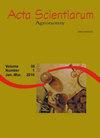方差分析中多重比较检验中的第一类误差
IF 1.2
4区 农林科学
Q3 AGRONOMY
引用次数: 1
摘要
在假设检验中,研究人员最初固定了一个I型错误率,即在零假设成立的情况下拒绝零假设的概率。在平均数调查的情况下,重要的是要提出与名义预先固定水平相等的第一类误差,以便该误差在各种情况下保持不变,包括处理次数、重复次数和变异系数。本研究的目的是分析和比较以下多项比较检验,以控制条件和无条件I型错误率,取决于方差分析中的显著f检验:Tukey, Duncan, Fisher 's least significant difference, Student-Newman-Keuls (SNK)和scheff本文章由计算机程序翻译,如有差异,请以英文原文为准。
Type I error in multiple comparison tests in analysis of variance
In a hypothesis test, a researcher initially fixes a type I error rate, that is, the probability of rejecting the null hypothesis given that it is true. In the case of means tests, it is important to present a type I error that is equal to the nominal pre-fixed level, such that this error remains unchanged across various scenarios, including the number of treatments, number of repetitions, and coefficient of variation. The purpose of this study is to analyse and compare the following multiple comparison tests for the control of both conditional and unconditional type I error rates, depending on a significant F-test in the analysis of variance: Tukey, Duncan, Fisher’s least significant difference, Student–Newman–Keuls (SNK), and Scheffé. As an application, we present a motivation study and develop a simulation study using the Monte Carlo method for a total of 64 scenarios. In each simulated scenario, we estimate the comparison-wise and experiment-wise error rates, conditional and unconditional on a significant result of the overall F-test of analysis of variance for each of the five multiple comparison tests evaluated. The results indicate that the application of the means tests based only on the significance of the F-test should be considered when determining the error rates, as this can change them. In addition, we find that Fisher’s test controls for the comparison-wise error rate, the Tukey and SNK tests control for the experiment-wise error rate, and the Duncan and Fisher tests control for the conditional experiment-wise error rate. Scheffé’s test does not control for any of the error rates considered.
求助全文
通过发布文献求助,成功后即可免费获取论文全文。
去求助
来源期刊

Acta Scientiarum. Agronomy.
Agricultural and Biological Sciences-Agronomy and Crop Science
CiteScore
2.40
自引率
0.00%
发文量
45
审稿时长
>12 weeks
期刊介绍:
The journal publishes original articles in all areas of Agronomy, including soil sciences, agricultural entomology, soil fertility and manuring, soil physics, physiology of cultivated plants, phytopathology, phyto-health, phytotechny, genesis, morphology and soil classification, management and conservation of soil, integrated management of plant pests, vegetal improvement, agricultural microbiology, agricultural parasitology, production and processing of seeds.
 求助内容:
求助内容: 应助结果提醒方式:
应助结果提醒方式:


